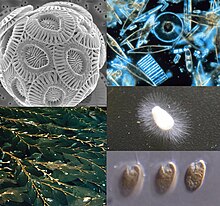Chromalveolata
| Chromalveolata | |
|---|---|
 |
|
| Clockwise from top-left: a haptophyte, some diatoms, a water mold, a cryptomonad, and Macrocystis, a phaeophyte | |
| Scientific classification | |
| Domain: | Eukaryota |
| (unranked) | Bikonta |
| (unranked): | Chromalveolata (monophyly in dispute) |
| Phyla | |
Chromalveolata is a eukaryote supergroup present in a major classification of 2005, then regarded as one of the six major groups within the eukaryotes. It is a refinement of the kingdom Chromista, first proposed by Thomas Cavalier-Smith in 1981. Chromalveolata was proposed to represent the organisms descended from a single secondary endosymbiosis involving a red alga and a bikont. The plastids in these organisms are those that contain chlorophyll c.
However, the monophyly of the Chromalveolata has been increasingly challenged. Thus, two papers published in 2008 have phylogenetic trees in which the chromalveolates are split up, and recent studies continue to support this view.
Historically, many chromalveolates were considered plants, because of their cell walls, photosynthetic ability, and in some cases their morphological resemblance to the land plants (Embryophyta). However, when the five-kingdom system (proposed in 1969) took prevalence over the animal–plant dichotomy, most of what we now call chromalveolates were put into the kingdom Protista, but the water molds and slime nets were put into the kingdom Fungi, while the brown algae stayed in the plant kingdom. These various organisms were later grouped together and given the name Chromalveolata by Cavalier-Smith. He believed them to be a monophyletic group, but this is apparently not the case.
In 2005, in a classification reflecting the consensus at the time, the Chromalveolata were regarded as one of the six major clades of eukaryotes. Although not given a formal taxonomic status in this classification, elsewhere the group has been treated as a Kingdom. The Chromalveolata were divided into four major subgroups:
...
Wikipedia
